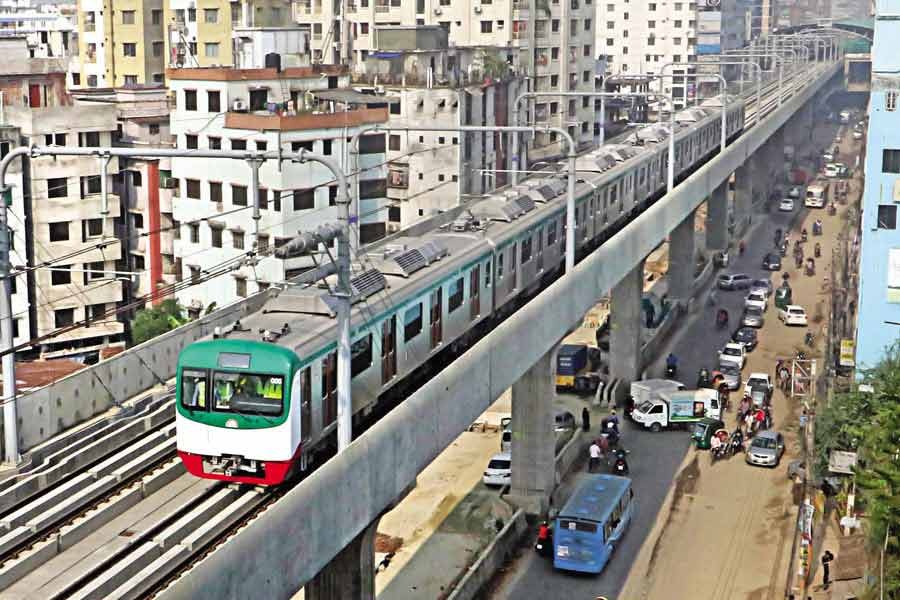Battling through the rumour mill run by the compulsively ever-complaining people, the outer façade of Uttara-Motijheel metro line was completed on January 28. It means a major preliminary part of the functional segment of Dhaka elevated metro rail has been completed. On that day the contractors of DMTCL (Dhaka Mass Transit Company Limited) installed the last concrete girder of the elevated railway. It was placed between the piers 582 and 583 beside the Jatiya Press Club in the city. With this installation work, the metro rail authorities almost completed this segment of work of the capital's metro rail. It has made the 20.1 kilometre viaduct-based railway visible.
For a developing status-aspirant country, where the major part of the communication network still lags behind that of the developed countries, putting into operation an elevated metro railway emerges as a virtual revolution. Few could think of the present state of progress in the installation of the overhead railway girders in just five years. The work of the MRT-6 (Mass Rapid Transit-6) began on 26 June 2016. The first segment of the high-speed railway is set to connect Uttara's Diabari to Agargaon, covering 11.73kilometres. It will be inaugurated on December 16 this year. The completed section extending up to Motijheel, covering 20.1 kilometres, will become operational by December 2023. The line is set to be taken up to Kamalapur. The railway track's extension and widening of the footpaths near the elevated stations for hassle-free movement of the train passengers etc will assumably lead to escalation of cost up from the original amount. According to DMTCL, building station plazas, transit-oriented facilities (TODs) and extension of the line to Kamalapur are also included in the works for the project's completion. Moreover, further land acquisition may require a large chunk of the additional money.
Keeping in view the multi-faceted stages of coping with major infrastructural projects and that too for the one like completing a 20.1 km metro track, the completion of MRT-6 appears to be one of the greatest challenges ever faced by the nation. To add to the woes of the implementing agency DMTCL, the Covid-19 pandemic has dealt a severe blow to the massive work. The more or less smooth progress of work was hampered mid-way by the sudden onslaught of the virus. Its chief informed the press that more than 100 employees, from contractors to field-level staff, had been infected with novel corona virus. However, the Managing Director seemed confident of his ability to achieve the goal finally. As with the commoners, corona virus had hit the metro rail construction project at different levels, he observed, saying they were trying to go ahead with the work coping with the existing pandemic situation. Unlike many other giant projects, as per official records, the MRT-6 line has a total of 442 spans between Uttara and Agargaon, 96 between Agargaon and Karwan Bazar, and 142 between Karwan Bazar and Motijheel.
A great amount of national image rests with the smooth completion of the MRT-6 project. That it will not elude Bangladesh has already been proved. Signs are there that the successful implementation of this elevated metro railway will radically change life in Bangladesh in many ways. Although this will benefit a small segment of the country, one shouldn't forget that the capital lies in it. Dhaka being the nerve-centre of all national activities, the capital-based metro network is expected to bring before the nation new vistas of openings to socio-economic opportunities. As it will add speed to some vital areas of life in the capital, the benefits of it are set to be enjoyed by the whole nation as domino effect. The commuting time of 40 minutesin place of over 2 hours is set to spring a veritably radical change in Dhaka's way of life. New daily routines in pursuing higher education, changed work schedules and lots of other new urban features are going to enable Dhaka to stand out --- with, of course, its speed attained by modern cities long ago. Optimists hope a completely overhauled Dhaka and Chattogram are waiting to be born from the morass of these two large cities struggling for decent survival. Come the corona-free hale and hearty days, resulting in the willingness to enjoy the beauty of urban life, the travels by metro rail in the larger cities could be found moulding the nation's development march.
According to the authorities, a total of six separate MRT Lines numbered 1,2,3,4 etc have been envisioned for the capital Dhaka. They will connect all parts of the city. Under the connectivity network, a north-south subway and a circular railway are also being mulled. With the near-complete MRT-6 linking Uttara with Motijheel, extending up to Kamalapur, and covering also Mirpur, the other five lines are set to operate in separate networks. As part of these routes' operation, MRT-1 will cover the Airport, Badda, Malibagh and Kamalapur Station areas and MRT-2 will cover Gabtoli, Mohammadpur, Azimpur, Demra etc. The rest five MRTs requiring a time-span of 2026-2030 may sound ambitious. But given the experience gathered from the 20.1km Uttara-Motijheel segment's completion, the future tasks are expected to be a lot easier.
Moreover, the commuters' satisfaction with the service is set to prompt the authorities to go ahead with their tasks in full energy. In the future, few areas in Dhaka will find themselves detached and 'neglected'. In a broader sphere this will be replicated in the districts to be benefitted by the Padma Bridge.This is how the goal-focused nations climb up the steps of development.


